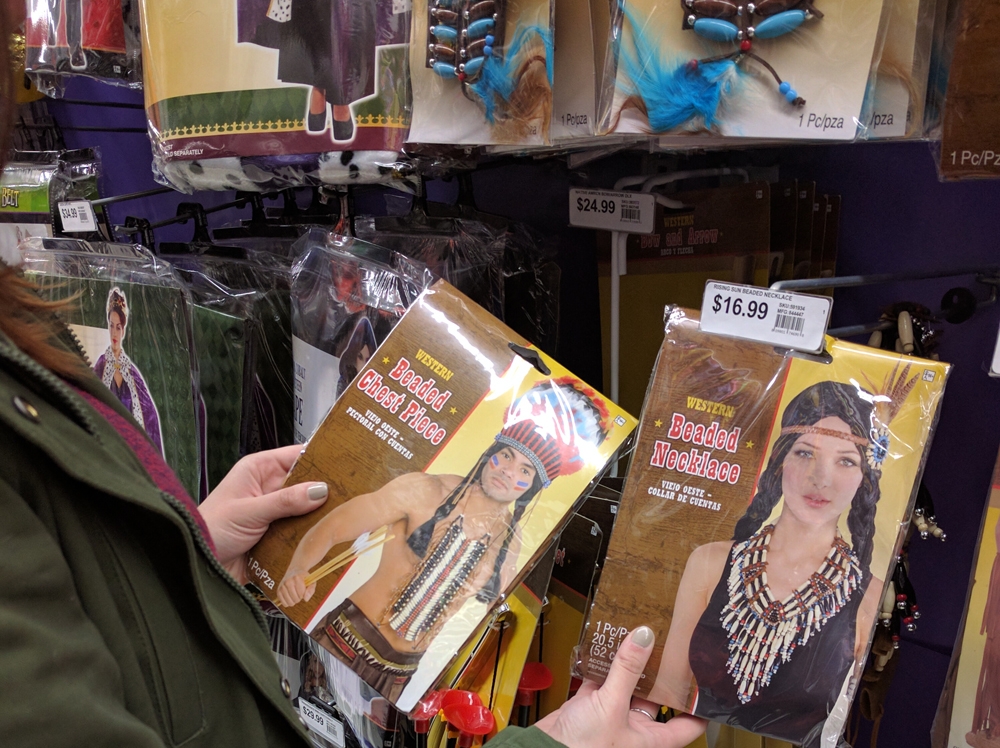Alex Kvaskov and Kanchi Uttamchandani | News Team
Featured image: Despite the outcry and claims of cultural appropriation, Halloween stores continue to sell Native and other cultural costumes. | Jenny Mao
An online petition is calling for Canadian retailers to ban Native costumes as the fallout from Brock University’s decision to ban allegedly offensive Halloween outfits continues to ripple across the country.
The ban-hammer has not yet descended on York, although segments of the university’s community want to police Halloween, claiming costumes should not mock marginalized groups.
Second-year psychology student Sadie Hamilton believes “Native” Halloween costumes are dehumanizing, as the image average Canadians have of Indigenous people is that of someone with a feather in their hair, wearing animal hides, with face paint and twin black braids.
“Because of this lack of positive or accurate representation available, I have struggled to feel valid in my identity as a Mohawk woman my whole life,” says Hamilton. She believes corporations profit from the belittling imagery of Indigenous people, while Indigenous communities continue to struggle without clean drinking water or access to healthcare.
Critics say banning costumes is censorship that misses the point of the playful and transgressive festival.
“There are clearly limits to this transgression: no responsible person advocates violence, acts of harm [or] real terror, but at the same time it is an occasion to let loose and confront stereotypes with humour and irony,” says history professor Nicholas Rogers.
“The wearing of a particular uniform, a ‘mask,’ is not really the issue. How it forms part of a performance might be. Is wearing an aboriginal costume in itself demeaning? If you start banning costumes, per se, where does it end?” he asks.
While the university does not have an official policy on Halloween costumes, it expects York community members to exercise good judgement. York’s Centre For Human Rights works closely with the university to distribute information to raise awareness about respectful practices to ensure an inclusive Halloween for everyone, according to Barbara Joy of York media.
“We will be distributing a message to the community via email and through LCD screens around campus that ‘Culture is not Costumes’. The message is already running on the LCD screens and other communications will be sent out in the coming days,” she says.
Rogers believes the “Cultures are not Costumes” campaign is counterproductive and constitues heavy-handed political correctness. “If you want to make people more appreciative of Aboriginal cultures and the challenges they face, pick another fight,” he argues.
York students offered a variety of opinions on the issue.
First-year visual arts student Erica Hirschfeld wonders if banning costumes is an effective solution, although she maintains that using cultural imagery for profit must end, especially when it grossly misrepresents a given culture.
“I have to wonder where the line is for banning costumes: does it stop explicit cultural misrepresentation seen in the costumes the petition references, or does it [or] will it extend to popular character costumes like Pocahontas?” she asks.
Hirschfeld adds that Halloween can be seen as a chance to educate people about other cultures instead of limiting imagination and creativity.
“If a little girl wants to dress up in a culturally inspired costume, parents, teachers and other adults should encourage her to research that culture and create a culturally accurate costume,” she says.
Third-year political science and criminology student Sajeth Paskaran highlights how dressing up as fictional characters, specifically Disney characters such as Mulan, Princess Jasmine and Pocahontas, can still be deemed cultural appropriation.
Paskaran argues society has become very politically correct and that people must consider this reality when dressing up. “Nevertheless, I would do my part to ensure that I am mindful of people’s lived experiences and be more aware of what can be deemed offensive or triggering to some people,” he says.
Hamilton argues the issue is much broader than mere political correctness and abuses humour by perpetuating harmful stereotypes of an oppressed minority. “All over Canada, our sisters, mothers and aunts go missing without a single headline. This issue is a brick in the wall which stands between us and reconciliation,” she says.
However, it is unclear how banning a costume addresses issues like the lack of clean drinking water on reserves and violence against Indigenous women.


